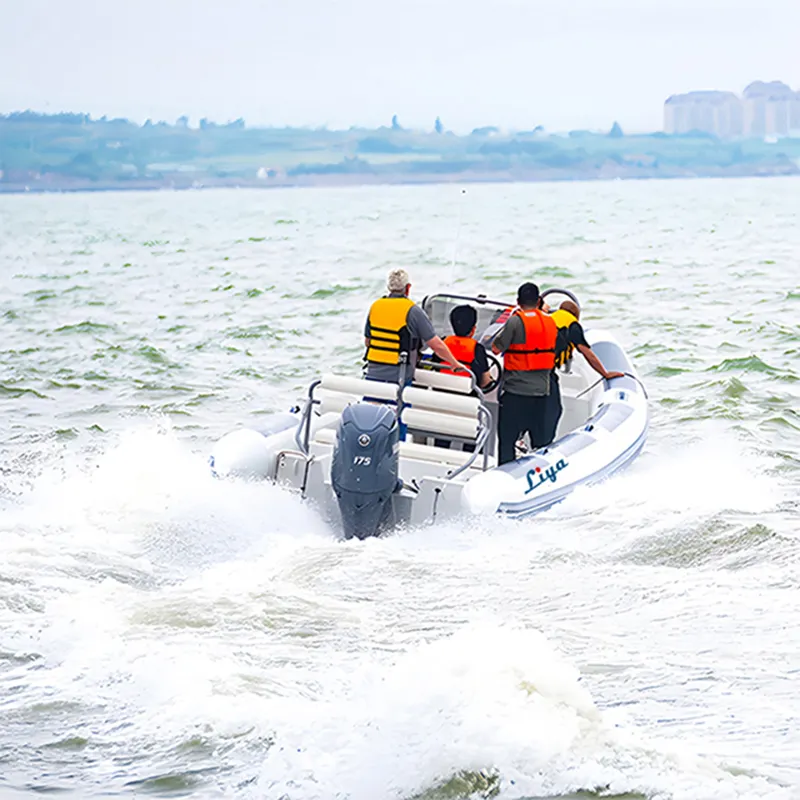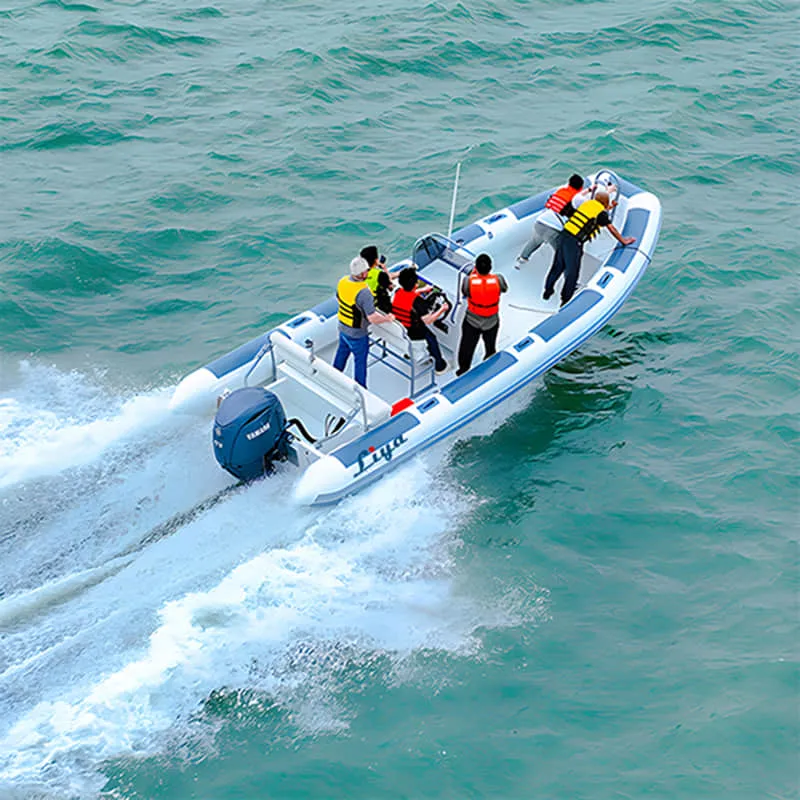Advanced Propulsion Systems in Navy RHIBs
Engine Power Requirements for High-Speed Naval Operations
Contemporary naval RHIBs need more than 850 bhp to achieve tactical speeds over 45 knots in open sea. An analysis of the 2024 Naval Engineering Journal showed twin-drive systems offer 22% quicker 0-30 knot times vs single-drives. These powerplants will need to provide 90% of torque at 2,800rpm under prolonged pursuits and remain below 35 dB(A) for low-sound insertion missions.
Dual-Configuration Propulsion for Tactical Flexibility
Powered by hybrid jet-drive/outboard propulsion systems that allow immediate switching between low draft (0.5m draft) shallow water operation and deep sea operations. 18% fuel savings were recorded in vessels equipped with switchable transmission modes versus fixed systems in the 2023 Maritime Propulsion Report. The Waterjet setups give 40° more turning at the helm than the stern drives, at 25+ knots, but 3 – 5 knots top speed, for higher trust and better turning capabilities.
Performance Metrics: Speed vs Fuel Efficiency Benchmarks
Military tasking calls for the RHIB to reach 2.1 nautical miles per gallon at 35 knots with 30% remaining fuel. Cruise efficiency is 15% greater with composite hulls than their aluminum counterparts in excess of 40 knot speeds. These metrics are traded against mission requirements – coastal interdiction demands quick dash speeds to get fast, open-ocean patrols need 12+hr endurance at 30kts loitering.
Tactical Weapon Integration on Navy RHIBs
Modular Mounting Systems for Mission-Specific Armament
Common mounting system easily allows the removal of the weapon from RHIB platforms onboard naval ships based on mission requirements i.e. counter-piracy patrols to combat insertion. Rail-track interfaces accommodate. 50 caliber machine gun, grenade launcher or anti-tank missile in minutes. Using modular equipment, measurements from the 2024 Naval Special Warfare exercise show that reconfiguration times reach <8 minutes, thus enabling warfighter combat readiness in temporary threat ramp-up. This interchangeability precludes specialized platforms by weapon type, and reduces acquisition costs by 22%, enabling the escalation of armament to confront asymmetrical threats.
Case Study: NSWC-approved Remote Weapon Stations
NSWC-validated remote weapon stations combine stabilized gyro-platforms and EO sensors to minimize the loss of target acquisition due to high-sea states beyond Sea State 5. Operators reach a 90% first-round hit probability against surface targets at a range of 800 meters during live-fire exercises, even when the vehicle is maneuvering. These NSWC-certified systems are designed with ease of operation in mind; touchscreen interfaces minimize control head time to <1.5 s per target transition, while cabin operation minimizes crew exposure. AI-guided threat awareness will be part of future versions to help shorten engaging sequences.
Military-Grade GPS Integration Standards
RFI To support such precision boat control operation with strong assurance, non-DoD sources Note: In order to achieve the necessary equipment must be able to comply with the requirement Navy need to be able to achieve accuracies within pCTL precision and accuracy requirements and to RHIBs require GPS systems that exceed commercial (e.g., within l-2m) (DL,0.1m) during high impact ensure pCTL operation in a GPS denied to ensure the operation of RHIBs in a military environment. Ruggedized versions of these modules pass MIL-STD test protocols, including saltwater immersion, vibration to more than 15G and EMI, and recent demand trends toward modular PNT architectures, combining INS and celestial navigation backups when satellite signals are jammed. GPS is prone to disruption by electronic warfare, jamming and other factors. The report from 2014 sited a number of operational scenarios in which GPS was compromised or non-existent and yet tri-redundant technology continued to operate all leading up to a successful test involving the remote activation and piloting by a convoy of RHIBs from a UK frigate taking place in Bermuda. Smaller than 18cm³ space-efficient antenna arrays allow continuous position reporting despite reducing deck footprint.
Encrypted Communication System Requirements
Military-grade naval shipboard networks will feature end-to-end voice and data encryption that complies with NSA Type-1 criteria, and mandatory frequency-hopping spread-spectrum anti-jamming technology. While preserving <100ms latency over UHF/VHF/SATCOM bands, systems must also support concurrent streaming of tactical imagery. Lightweight encrypted dual AES-256 communication…both transmitters and receivers weigh in under 5kg each per console. Interoperability requirements include interoperability with Joint Tactical Radio System waveforms, and auto-generation of KOV-28 encryption key cycling every 24 hours. Through live-fire tests, RHIB’s fitted with conformal blade antennas achieved 99.8% message integrity in signal dense environments, according to 2023 Naval Information Warfare Center validation trials.

Hull Design Innovations for Navy RHIBs
Hydrodynamic Efficiency in High-Seas Conditions
The hulls of modern naval RHIBs use CFD analysis to optimize hull design in terms of transverse load distribution in waves higher than Sea state 4. Stepped hulls reduce the exposed hull area in contact with the ocean by 18–22% below the sting 1 enabling speed in excess of 45+knots to be maintained while reducing the vertical acceleration forces by 21% (USNI Proceedings 2025). The inclusion of built-in incorporated spray rails in the SD console, and the use of variable-deadrise bows helps eliminate steering instability in high-speed turns - a massive leap forward outlined at the 2024 Naval Materials Symposium. These advancements are driven by the reality that 68% of crew injury incidents are the result of choppy state transits (Naval Safety Center 2023).
Composite Materials for Ballistic Protection
Aramid fiber, ceramic matrix, and thermoplastic resin three-layer composite armor systems provide Level III NIJ-rated protection at up to 40% lower weight than traditional steel plates. Recent MIL-STD-810 testing demonstrates that these materials stop 7.62–51mm API rounds, and prove capable of maintaining structural integrity in excess of 2,000 hours of saltwater submergence. The composites provide eight times as much lifecycle corrosion resistance as conventional aluminum alloys, thus clearly reducing course maintenance costs for a defense supply activity (2024).
Launch and Recovery System Specifications
Mothership Interface Compatibility Standards
State-of-the-art RHIB launch systems for naval vessels must be fully integrable with all types of ships, ranging from a destroyer to an amphibious assault vessel. We regret they have to spend all this money only because they have davit systems that are not STANAG 25 boat module compliant. Key performance figures are 25,000-pound dynamic load capability (proven to NATO Sea State 3 conditions) and shock mitigation systems meeting ISO 14829-2. Modular connection systems enable the RHIBs to connect to both A-frame cranes and hydraulic davit systems without structural modifications. A 2022 Naval Sea Systems Command review determined that ships that complied with the MIL-STD-1625D interface requirements experienced a 67% reduction in failures during deployment compared to older systems, said the official, describing testing they invested in on the expeditionary sea base class ships.
Rapid Deployment Mechanisms in Combat Scenarios
RHIB launch systems must be battle-ready, with sub 60-second launch cycles and less than 0.5° “pitch and yaw” stability during crane operations. Davit systems that hydraulically rotate 360 degrees provide the ability to launch multiple RHIBs simultaneously which is vital during mass personnel extraction operations. Recent field trials indicate that systems which incorporate dynamic stabilization rigs and automatic release hooks achieve 92% operational readiness in Sea State 4 situations. Ships with dual winch/launch and recovery systems (LARS) cut down crucial mission delay times by 41% in contested recovery scenarios in 2023 Naval Engineering Journal. More advanced models have recovery beams that are GPS traced and keep the sub- even during mothership gyrations at 12 knots to within better than 1.5 meters, which is necessary for Special Operations forces insertions under fire.
Durability Testing and Maintenance Protocols
Saltwater Corrosion Resistance Certification Levels
Military RHIBs require compliance with MIL-STD-2031 for saltwater exposure, mandating 5,000+ hours of accelerated corrosion testing. Recent NACE International data (2023) shows naval equipment adhering to ISO 9227 standards experiences 73% less material degradation in chloride-rich environments. Three-tier certification systems now evaluate:
- Surface coating integrity after cyclic salt-fog exposure
- Galvanic corrosion rates at welded joints
- Electrical system resistance to micro-pitting
Platforms exceeding Level III thresholds demonstrate <0.25 mm/year corrosion penetration rates even in sustained 8-knot operational speeds, based on hydrodynamic stress simulations.
Preventive Maintenance Cycles for Critical Components
Condition-Based Monitoring (CBM) systems reduce unscheduled RHIB downtime by 41% compared to calendar-based approaches (SNAME 2022 study). Critical path analysis prioritizes:
- Drive systems: 500-hour lubricant spectral analysis
- Composite hulls: Triennial dielectric moisture testing
- Weapon interfaces: Bi-annual connector pin resistance checks
Predictive algorithms process real-time data from 14+ onboard sensors, triggering maintenance alerts when parameters deviate 7% from baseline. This strategy extends propulsion system lifespans by 2.8 years on average while maintaining 98.6% mission readiness rates.
FAQs
What is the significance of dual-configuration propulsion systems?
Dual-configuration propulsion systems provide tactical flexibility, allowing naval RHIBs to operate efficiently in both shallow and deep waters by swiftly switching between jet-drive and outboard systems.
How do composite hulls improve performance?
Composite hulls enhance cruise efficiency by 15% over aluminum counterparts at speeds greater than 40 knots, offering better endurance and fuel efficiency essential for military operations.
What technologies ensure GPS reliability in challenging environments?
RHIBs use ruggedized GPS systems with modular PNT architectures, incorporating INS and celestial navigation backups to ensure reliable navigation even when satellite signals are compromised.
How do modular mounting systems benefit naval missions?
Modular mounting systems offer quick reconfiguration times, allowing naval RHIBs to adapt armament swiftly according to mission needs, which reduces acquisition costs and enhances combat readiness.
What are Condition-Based Monitoring (CBM) systems?
CBM systems use real-time sensor data to predict maintenance needs, reducing unscheduled downtime and extending the lifespan of propulsion systems, thus achieving higher mission readiness rates.

